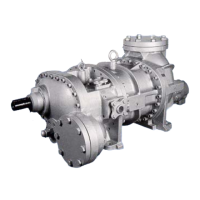REFRIGERATION DIVISION
V SERIES
SCREW COMPRESSOR HANDLING MANUAL
Supersedes all previous version. This information is for reference use only and subject to change without notice
Revision 2 (June 05,2000) Page 21 of 61
3. Disassembly of V-Series
3.1 Preparations for Disassembly
Disassembly work on a base-mounted compressor unit is limited to the shaft seal; thrust bearing,
unloader cylinder and balance piston section. Disassembly and inspection work on other parts of the
compressor should be done with the unit removed from the base and positioned for maximum access
and ease of disassembly.
Disassembly and inspection work as well as handling of compressor parts should only be undertaken
after carefully reading the instructions given in this manual.
3.2 Hand Tool Kit (ref. last page)
Common hand tools such as a hammer, monkey wrench, file, scraper, sandpaper (fine grain) as well
as the hand tool kit supplied with the compressor should be prepared prior to commencing
disassembly work. In addition cleaning fluid, fresh lubricating oil, and waste cloth should be available.
Work is best performed on a large surface plate positioned on a suitably large workbench.
If a surface plate is unavailable, a steel plate having dimensions of at least 800 mm x 1,000 mm and
supported on a low stand is a good substitute.
Needless to say, work should be performed in a location that is well lit, dry and free from sand and
dust.
3.3 Removing Compressor
3.3.1 Recovering Refrigerant
Refrigerant under high pressure is sealed up to the check valve of the screw compressor unit. Before
the compressor is removed from the base, internal pressure should be reduced to atmospheric or
slightly lower pressure.
The methods for reducing pressure inside the compressor vary according to the type of compressor.
In the case of a Freon refrigerant system, the following method should be used in order to prevent
refrigerant gas from being discharged into the atmosphere.
a) Transfer the refrigerant to the low-pressure side of the system using a bypass valve.
b) If the system incorporates two or more compressors, draw out the refrigerant from one
compressor to another (while operating the other compressor).
c) Recover the refrigerant using a small, portable compressor.
Whatever the method, the compressor should be disconnected with a slight positive pressure and the
temperature the same or slightly higher than ambient air temperature. If it is disconnected with the
inside under vacuum and the temperature lower than the ambient air temperature, air and moisture
readily enter and may condense, leading to freezing at low temperature.
3.3.2 Disconnecting Auxiliary Equipment
Disconnect parts such as the drive coupling, suction/discharge piping, lubrication piping and other
pipes such as those for liquid injection and the economizer as well as all control wiring and mounting
bolts.
When removing piping, a drain pan should be positioned under the joint being loosened to catch oil drips.

